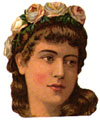

|
page 2 of 7 |


|
A child of the seventies, I naturally grew up being
influenced by the values of the time period. People
wanted harmony in their lives and in their hair.
Herbs were big--herbal tea, herbal home remedies,
and Herbal Essence shampoo. I liked the picture
on the Herbal Essence label, of a long-haired
woman in water, with flowers floating all around
her. I didn't like herbal tea.
As the decade progressed, my parents got heavy into the "natural" thing. Dad started making yogurt and candles. My mother cooked up veggie burgers. When I was ten, they bought all our food from an organic farm store in Pennsylvania. One of their first purchases was some natural, blue, peppermint shampoo. By that time, however, my consumer sensibilities had designated peppermint a dental hygiene flavor that was inappropriate--disgusting actually--in a shampoo. Plus, I wanted to be a Mary Tyler Moore or Marlo Thomas type--adventurous, perky, a little bit daffy but smart--and would have preferred to use an All-American Girl shampoo--like strawberry Suave or Pert--to affect my transformation. But I was still at the mercy of my parents' taste, as they searched for a shampoo that spoke not just to their follicles, but to their souls as well. In my early teen years, however, I asserted my hygiene independence. Shampoo became a topic of serious discussion for me and my friends. I conducted careful demographic research at numerous slumber parties. My first big find was Gee, Your Hair Smells Terrific. Their commercials depicted a Teen Dreamboat giving flowers to a GYHST-girl. I wanted to be that girl. Unfortunately, GYHST failed to work its magic; I never got any flowers. I also realized GYHST was kind of an embarrassment to have in the family shopping cart. My reasoning was this: if you're buying a shampoo called Gee, Your Hair Smells Terrific, you obviously care about smelling good. If you care about smelling good, you obviously care about attracting boys. |


